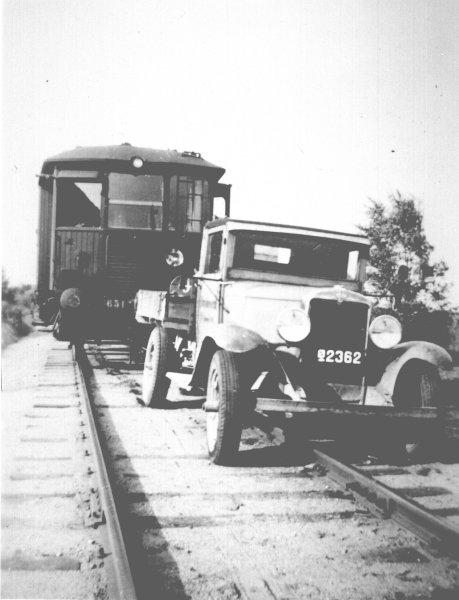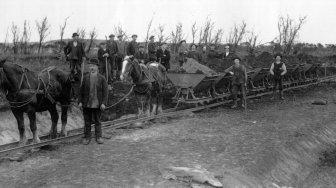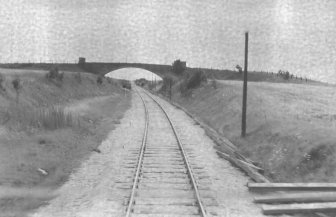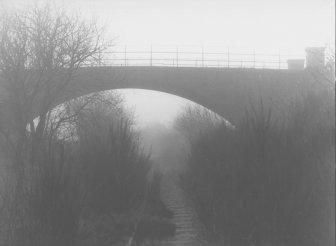From charcoal to bread
Skjern – Videbæk track history
(Source: Skjern-Videbæk Nov. 1995)

Videbæk was already in the picture in the 1870s during the discussion about a railway facility in West Jutland.
In 1879, a railway system from Herning via Videbæk to Skjern was discussed in detail, but the route came instead to go over Kibæk – Troldhede. After the turn of the century, discussions began again about railway facilities, and in 1901 a proposal was made for a railway between Skive and Herning. As a result, local MPs proposed a route from Skive to Skjern.
A large number of meetings were held about this – also in Videbæk. In the proposal for the great railway law of 1908, the Folketing agreed on the construction of a state railway Skjern – Skive. The county council could not accept the construction of the section Skjern – Skive and the project was cut to Skjern – Videbæk; however, with the addition that it could later be extended to Skive. An amendment to have the track run as a private track was met with both local opposition and opposition in Copenhagen – the municipalities in the track’s catchment area did not have the money for such a facility.
The state railway Skjern – Videbæk was included in the Railways Act of 27 May 1908. But it would be many years before it was realized. In October 1916 the line was laid. There were two alternative alignments – one western and one eastern; the western was chosen.

Work on the track began in January 1918. The track was built with 32 kg / m rails, and already at the building an extension from Videbæk in a northeasterly direction was expected. Therefore, Videbæk station was placed a little awkwardly for the town of Videbæk itself.
In the National Assembly, 1916 – 1917 and 1917 – 1918, the government submitted a bill on the construction of the Videbæk – Skive line, but it was not adopted until 6 May 1921. The line was to be built as a state line with a municipal subsidy of DKK 3,333.00 per. kilometer. In 1921, the extension was estimated at DKK 13-14 million.
The Skjern – Videbæk line cost a total of DKK 2,572,000, and it was ready in the autumn of 1920. The line was opened for operation on 15 November 1920 without much ceremony.
The line was manned by DSB according to the state procedures’ normal procedure. Videbæk station thus had a stationmaster, an assistant and three porters. The stations Herborg, Sædding and Kongsholm each had a station master. Furthermore, the siding at Risdal was managed by a porter.
Strækningen

From Skjern, the track follows the longitudinal track and runs the first 4 – 5 km along the main road A11. Kongsholm station is 5.0 km from Skjern by the road to Bølling church and quite deserted. The station’s loading track was shut down and removed on December 1, 1970, as it was worn out due to poor maintenance. Sædding station is located 9.2 km from Skjern – east of the settlement Rækker Mølle. Sædding station had loading tracks and crossing tracks, which were removed in 1970.
12.8 km from Skjern was Risdal step board. In the years 1920 – 22 there was a loading track, where for a period very large amounts of lignite were loaded. The lignite was supplied by tipper truck track, and a major customer was the City of Copenhagen. 30 loaded wagons a day was normal.
Herborg station is located 15.1 km from Skjern southwest of Herborg church. Herborg also lost its loading tracks in 1970 following a recommendation from the Railway Service. Videbæk station is 19.5 km from Skjern. The station itself was built 400 m north of the country road. Following a recommendation from local users, a step board was laid in 1930 at the crossing at the main road covered by the station’s signals. Videbæk station had two tracks for passenger trains and a bypass track with plug tracks for the end ramp. At the north-eastern end of the station was a single-track locomotive depot with a 13 m turntable in front. After the closure of passenger traffic, the station area was sold and new loading tracks were built immediately south of the main road.
World War II
The traffic did not turn out as hoped and already in 1928, the Videbæk civic association was drawn into the discussions about the future of the railway. In 1930, DSB set up a committee to investigate a number of side lanes, including the Skjern – Videbæk line. The committee came up with several solutions:
- Closure of passenger traffic and continuation of freight traffic with a shunting tractor from Skjern.
- Motorization of passenger traffic with light motor vehicles (steam locomotives of letter J, a 3rd class passenger car liter CCB, a passenger car for 2nd and 3rd class letter Bf and a van Ed on the track were used at the time of the investigation).

But after local activity about the future of the track, the small petrol motor cars litra Me were allowed to continue driving.
During World War 2, the course was again very full. Now the trains were again so large that steam locomotives had to be used again. Where in the first year of the railway steam locomotives of letters A and B and G were used, during World War II it was letters G and O, while letters K and D machines were sporadically used. It was machines from Århus that, during their stay in Skjern, drove these trains back and forth to Videbæk, before returning again from Skjern via Herning to Skanderborg and Århus.

After World War II, when supplies returned to normal, the small Triangle motor vehicles returned, this time in the form of the MC and the MF. Six trains continued to run daily between Skjern and Videbæk – with a maximum of 45 km / h. When the small triangle of motor vehicles were worn out by hand, passenger traffic was shut down on 2 October 1955. Freight traffic then continued for the next 26 years. But on June 1, 1981, this traffic was also suspended.
The track is closed
After that, the track lay dormant for the next 19 years. In 1990, the state railways wanted to sell the track to Skjern and Videbæk municipalities, and in 1993 the track was bought by the 2 municipalities and Ringkjøbing County for DKK 100,000. The track was then handed over to Skjern-Videbæk Veteran Railway (VSVJ), which was founded the year before, on 24 July 1992.
On 22 December 1998, VSVJ was merged with VestJysk Model-Jernbane and the track is used today for traveling with rail bikes, where Videbæk-Skjern Veteran- og Modeljernbane rents out and maintains 15 bikes. In addition, the association has working equipment for the maintenance of the track.

